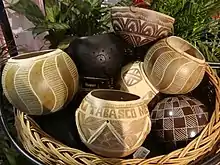calabash
English
WOTD – 7 August 2019
Etymology
From French calebasse, from Spanish calabaza (“gourd; pumpkin”), possibly from Arabic قَرْعَة يَابِسَة (qarʿa(t) yābisa, “dry gourd”) or directly from its etymon Persian خربزه (xarboza, xarboze, “melon”),[1][2] possibly ultimately from Sanskrit त्रपुस (trapusa, “colocynth fruit”) (compare Persian تربز (tarboz(e), “watermelon”)). The English word is cognate with Catalan carabassa (“pumpkin; orange colour”), Galician cabaza (“gourd, pumpkin, squash; calabash (container)”), Occitan calebasso, carabasso, carbasso, Portuguese cabaça (“gourd; calabash (container)”), Sicilian caravazza.[1]
Pronunciation
- (Received Pronunciation) IPA(key): /ˈkæləbæʃ/
Audio (RP) (file) - (General American) IPA(key): /ˈkæləˌbæʃ/
- Hyphenation: ca‧la‧bash
Noun
calabash (plural calabashes)
- A tree (known as the calabash tree; Crescentia cujete) native to Central and South America, the West Indies, and southern Florida, bearing large, round fruit used to make containers (sense 3); the fruit of this tree.
- 1821, Alexander de Humboldt [i.e., Alexander von Humboldt]; Aimé Bonpland, chapter XXI, in Helen Maria Williams, transl., Personal Narrative of Travels to the Equinoctial Regions of the New Continent, during the Years 1799–1804. [...] Written in French […], and Translated into English […], volume V, London: Printed for Longman, Hurst, Rees, Orme, and Brown, […], OCLC 861227170, book VII, page 129:
- As we were absolutely destitute of large vessels, to contain and mix liquids, we poured, by means of a tutuma (fruit of crescentia cujete, calabash), the water of the river into one of the holes of the rock. To this we added sugar, and the juice of acid fruits. In a few minutes we had an excellent beverage, which was almost a refinement of luxury in that wild spot; [...]
- 1870, “Goso, the Teacher”, in Edward Steere, transl., Swahili Tales, as Told by Natives of Zanzibar. With an English Translation, London: Bell & Daldy, […], OCLC 250333102, page 287:
- There was a teacher who taught children to read under a calabash tree, and this teacher's name was Goso.
-
- The bottle gourd (calabash vine, Lagenaria siceraria), believed to have originated in Africa, which is grown for its fruit that are used as a vegetable and to make containers (sense 3); the fruit of this plant.
- 1839 January, “L.”, “The Calabash (Cucurbita Lagenaria)”, in The Visitor, or Monthly Instructor, London: The Religious Tract Society; [...] sold by John Davis, […], OCLC 740304389, page 75:
- The calabash, is a kind of gourd, and belongs to that family of twining plants which were called among the Hebrews, "wild vines," but by the botanists of modern times, the cucurbitaceæ, or cucurbitaceous plants. [...] That playful variety of form and magnitude, so remarkable in the calabash, renders it fit for all kinds of uses. Sometimes we have a globular base, terminating in a long neck, and then it answers the purpose of a bottle, and the American fastens it to his girdle, or the pommel of his saddle, when about to pass through regions which abound not in water.
- 2008, James A. Duke; with Peggy-Ann K. Duke and Judith L. duCellie, “Catalog of ‘Faith-based’ Farmaceuticals”, in Duke’s Handbook of Medicinal Plants of the Bible, Boca Raton, Fla.: CRC Press, →ISBN, page 233:
- CALABASH GOURD (LAGENARIA SICERARIA) [...] Appropriately bowing to AHP, the American Herbal Products Association, for the betterment of the herbal industry, I will now use its standardized common name, Calabash Gourd, a vine, not to be confused with the Calabash tree (Crescentia).
- 2009, Charlie Nardozzi and editors of the National Gardening Association, “Sweet Corn and an A to T of Other Worthy Veggies”, in Vegetable Gardening for Dummies (For Dummies series), 2nd edition, Hoboken, N.J.: Wiley Publishing, →ISBN, part II (Vegging Out), page 167:
- Asian gourds grow like cucumbers [...] and feature strong flavors that are often used in Indian, Chinese, and Southeast Asian soups and stews. Some types to try in your garden include the bitter gourd and calabash gourd.
-
- A container made from the mature, dried shell of the fruit of one of the above plants; also, a similarly shaped container made from some other material.
- 1799, Mungo Park, “Of Gold-dust, and the Manner in which It is Collected.—Process of Washing it.— […]”, in Travels in the Interior Districts of Africa: Performed under the Direction and Patronage of the African Association, in the Years 1795, 1796, and 1797. […], London: Printed by W[illiam] Bulmer and Co. for the author; and sold by G[eorge] and W[illiam] Nicol, […], OCLC 883610022, page 302:
- [T]he manner of separating the gold from the sand, is very simple, and is frequently performed by the women in the middle of the town; for when the searchers return from the valleys in the evening, they commonly bring with them each a calabash or two of sand, to be washed by such of the females as remain at home.
- 1851 November 14, Herman Melville, “Wheelbarrow” and “The Prophet”, in Moby-Dick; or, The Whale, 1st American edition, New York, N.Y.: Harper & Brothers; London: Richard Bentley, OCLC 57395299, pages 65 and 105:
- [page 65] The people of his island of Rokovoko, it seems, at their wedding feasts express the fragrant water of young cocoanuts into a large stained calabash like a punchbowl; and this punchbowl always forms the great central ornament on the braided mat where the feast is held. [...] [page 105] [I]t seemed to me that he was dogging us, but with what intent I could not for the life of me imagine. This circumstance, coupled with his ambiguous, half-hinting, half-revealing, shrouded sort of talk, now begat in me all kinds of vague wonderments and half-apprehensions, and all connected with the Pequod; and Captain Ahab; and the leg he had lost; and the Cape Horn fit; and the silver calabash; [...]
- 1997, Olajire Olanlokun, chapter 3, in Karen Morrison, editor, The Missing Calabash, Oxford; Gaborone, Botswana: Heinemann Educational Publishers, →ISBN, page 13:
- Saje put the calabash in the king's hands. There was a hush from the crowd. The calabash was large and painted with beautiful designs. Few people had seen it up close.
- 2003, Gabriel García Márquez, chapter 2, in Edith Grossman, transl., Living to Tell the Tale: Translated from the Spanish, New York, N.Y.: Alfred A. Knopf, →ISBN:
- [...] we would pour water from the tank over ourselves with a calabash and finish by splashing on the Agua Florida from Lanman & Kemps [...]
- 2009 January 7, Mike Pflanz, “Nigerian motorcyclists arrested for wearing pumpkin helmets”, in The Daily Telegraph, London: Telegraph Media Group, ISSN 0307-1235, OCLC 635239717, archived from the original on 22 May 2010:
- [T]he motorcycle drivers say that new helmets are too expensive and instead have been found wearing pumpkin-like calabashes – dried fruit shells usually used to carry water – cooking pots tied with string or strips of rubber from old tyres.
-
- A calabash and its contents; as much as fills such a container.
- 1981, T[homas] Coraghessan Boyle, “The Niger”, in Water Music, Boston, Mass.: Little, Brown, →ISBN; republished London: Granta Books, 1998, →ISBN:
- Amuta and the twelve-year-old have produced calabashes of palm wine and are busy pouring out healthy drams into the cupped hands of black and white alike.
- 2015, Michael [D.] Jackson, “Petra’s Letter”, in Harmattan: A Philosophical Fiction, New York, N.Y.; Chichester, West Sussex: Columbia University Press, →ISBN, part 2 (Harmattan), page 122:
- It was dusk by the time Yandi reappeared, carrying a calabash of parboiled rice and a peanut and chili sauce on his head.
-
- (music) A musical instrument, most commonly a drum or rattle, made from a calabash fruit.
- 1814, Jerom Merolla da Sorrento, “A Voyage to Congo, and Several Other Countries, Chiefly in Southern Africk. […]”, in John Pinkerton, A General Collection of the Best and Most Interesting Voyages and Travels in All Parts of the World; […], volume XVI, London: Printed for Longman, Hurst, Rees, Orme,and Brown, […]; and Cadell and Davies, […], OCLC 156146323, page 245:
- The inſtrument moſt in requeſt uſed by the Abundi, being the people of the kingdom of Angola, Matamba, and others, is the Marimba; it conſiſts of ſixteen calabaſhes orderly placed along the middle between two ſide-boards joined together, or a long frame, hanging about a man's neck with a thong. Over the mouths of the calabaſhes there are thin ſounding ſlips of red wood called Tanilla, a little above a ſpan long, which being beaten with two little ſticks, returns a ſound from the calabaſhes of ſeveral ſizes not unlike an organ.
-
Derived terms
- black calabash (Crescentia ovata)
- calabash chalk
- calabash nutmeg (Monodora myristica)
- calabash pipe
- calabash tree (Crescentia cujete)
- calabash vine (Lagenaria siceraria)
- Mexican calabash (Crescentia alata)
- sweet calabash (Passiflora maliformis)
- winged calabash (Crescentia alata)
Translations
Crescentia cujete
Lagenaria siceraria
|
fruit of the Lagenaria siceraria
container made from the shell of the fruit of one of the above plants
|
a calabash and its contents; as much as fills such a container
musical instrument
- The translations below need to be checked and inserted above into the appropriate translation tables, removing any numbers. Numbers do not necessarily match those in definitions. See instructions at Wiktionary:Entry layout#Translations.
References
- “calabash, n.”, in OED Online

- “calabash, n.” in Lexico, Dictionary.com; Oxford University Press.
Further reading


This article is issued from Wiktionary. The text is licensed under Creative Commons - Attribution - Sharealike. Additional terms may apply for the media files.



